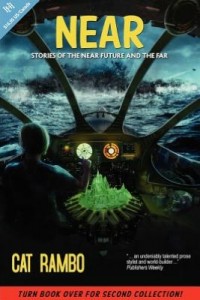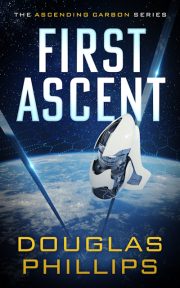An Interview with Don Sakers
by Cat Rambo

SF writer, fan, and reviewer Don Sakers’ latest book is The Eighth Succession, another installment in his Scattered Worlds series. Since 2009 he’s reviewed SF for Analog, but his day job is a librarian with the Anne Arundel County Library.
Q: Melissa Scott described Dance for the Ivory Madonna as a book written by “a leftwing Robert Heinlein.” How accurate do you find that comparison?
A: Obviously I’m very flattered by the description. I’m a lifelong
student of Heinlein’s work, and I’ve tried to emulate two aspects of his work in particular.
The first is his method of extrapolation, which is to identify trends in present society and project them into the future on a logarithmic rather than straight-line track — and then to reason out ways those trends would affect ordinary people. In other words, he didn’t just project that there would be government and military bases on the moon…he projected that cereal companies would give away moon trips and spacesuits as contest prizes.
In Dance for the Ivory Madonna (published in 2002), for example, I took the trends of virtual reality, Moore’s Law, and wearable computing and extrapolated 40 years to ubiquitous, stylish data spectacles (I called them RCSpex; today Google calls their ancestors “Glass”) — and then figured that so many people would do so much of their business in virtual worlds that the shopping center down the street would be closed and overgrown with weeds. And that car designers would manufacture drab vehicles, then make their money selling changeable virtual skins that owners could project to the world.
The other aspect of Heinlein’s work that I’ve tried to emulate is his ability to choose and present just a few precise details to convey a different world, be it the future or another planet. The classic example from his own work is the phrase, “The door dilated.”
In Dance for the Ivory Madonna (and my other sf work) I’ve tried to use the same technique. For example, in one scene I referred to the main character who “nibbles from trays of hors d’oeuvres carried by servbots, sips from a pint mug of Enhanced Coke, and enjoys the light buzz that comes as much from the electrified air as from the drink.”
As for the “leftwing” part of the description — well, as a student of Heinlein’s work, I know that anyone who claims to discern his real political beliefs from his writing has missed something. I’ve said for years, “Name me a political philosophy, and I’ll find you a passage in Heinlein that supports it.”
In Dance for the Ivory Madonna I speak approvingly of contract government, populism, rational humanism, nuclear power, population control, international government, cultural diversity, artistic creativity, and equality of gender, sexuality, race, body type, and species. I speak disparagingly of theocracy, racism, sexism, intolerance, mindless environmentalism, Baby Boomers, police, modern education, and four kinds of nationalism.
So you tell me.
Q: You refer to your Scattered Worlds series as a mosaic, and readers can enter it through a number of different books. How complete is the Scattered Worlds universe in your head, and what important pieces of it remain missing?
I call the Scattered Worlds series a mosaic because while it’s composed of individual, standalone units, it also has a larger design, an overarching story that I hope makes that whole thing more than the sum of its parts.
Currently there are six novels and three shorter pieces in print. I have another dozen or so books planned (some already written in one form or another), and probably two or three dozen shorter pieces.
In my head and on paper, the “grand design” is essentially complete, and has been for 25 years or so. The final books (I envision at least two novels and possibly three) will draw together threads and pieces from all the others. In between now and then, there are — oh, let’s call it half a dozen “backbone” books.
And since this is all set against a single consistent background covering about 2.5 billion years, there’s plenty of room for side books and stories exploring and fleshing out specific things. A Rose from Old Terra and A Voice in Every Wind were such side books; if you don’t read them, you won’t find the mosaic all that diminished. The Eighth Succession and The Leaves of October are backbone titles — without them, the grand design is much harder to distinguish.
What important parts are missing? It should come as no surprise to SFWA members that what’s missing is the fleshing-out that comes from actually writing those books (i.e. the hard work). You can have the best plot structure and character sketches in the world, but in order to bring them to life you have to write the story.
To be a specific as I can…I have one character who is good and noble and all — but at the climactic moment of the grand design, is going to be tempted and give in. I know exactly what that scene’s going to look like. What’s missing is the whole story of how he got to be so noble and good, what other temptations he’s faced and how he resisted them, and why that final temptation has the power to break him.
Oh, I know the factual answers to those questions — but factual answers aren’t a story. And this character’s fall won’t be believable until all the stories that answer those questions are told.
Q: One of the things the Scattered Worlds books do is not just explore technology but rather its implications for humans and the societal changes it creates. How do you go about figuring out how society might change?
A: That’s a big one with lots of little answers. Reading those who do it well: Heinlein, Asimov, Pohl, Jack McDevitt, Kim Stanley Robinson, Joan Slonczewski, and many others. Reading those who do it badly, and I won’t name any names. Reading contemporary futurists and technologists. Having a firm grounding in history — any history, but particularly other periods of technological change. And paying attention to how technology has changed things in my own lifetime…I was born just as the Space Age was starting.
Bear in mind that the sf writer isn’t trying to predict the future, only show a plausible possible future. Any halfway-accurate predictions that take place (cough, Google Glass) are incidental.
There are a few tricks of the trade that I haven’t seen explicitly stated elsewhere, but aren’t exactly secret. One is to look at what present-day technologists are saying and either assume the opposite, or try to see what they’re missing. Tech people always overestimate the appeal of tech and always underestimate the importance of social forces. Technologists were quick to dismiss the iPod because it was proprietary (the future is with open systems) — and as far as I know, none of them said “This is going to lead to a cottage industry in self-syndicated radio shows” (we call them podcasts).
Another trick of the trade is to look for inconsistency. In sf as in technology writing, we have this notion that new technology will inevitably and universally displace old technology, and quickly. That’s not the way the real world works. Let me give you a real-life example. In the 1970s I heard a respected sf writer criticize another’s work by saying “In a world with cheap high-speed transcontinental transportation, no one would drive from coast to coast.” Yet in 2006 (with transcontinental air fares running about five cents a mile), my husband and I DID drive from Baltimore to Los Angeles for Worldcon and back, making a grand adventure out of it.
Sometimes your societal changes will look more realistic if you include some contradictions. A popular bit in Dance for the Ivory Madonna is set in a seceded “Christian States of America” in which net traffic is deliberately limited and public executions by burning are common. I describe two totally different methods of getting to space, and there are hints of several others. Slow cargo airships coexist with cheap suborbital flights and supersonic trains.
The real world is a complex place with many contradictions. The more you can give your future worlds the appearance of such complexity, the more believable they’ll be.
Q: You often invoke music in your work, particularly filk references. Are you musically inclined?
A: I’m the ultimate music consumer; I have virtually no musical talent of my own, but I love the stuff. I play no instruments (which made it challenging to write a character who was a harpist), my singing voice is very definitely of shower quality, I wouldn’t know an eighth note if it bit me, and I’m still struggling to find someone who can hammer an understanding of “syncopation” into my head.
But I love music. It communicates on some of the same unconscious levels that a good story does. Moreover, music can be a private thing or it can be powerfully communal. Music is also the present-day vehicle for poetry — the Brownings and Keatses and T.S. Eliots of today are up on stage with instrumental backup, singing. Music is transcultural and in some instances, trans-species.
Moreover, music makes a dandy metaphor in science fiction. In A Voice in Every Wind, I dealt with an alien race that communicates primarily through the chemical senses, scent and taste, rather than sight and hearing. Music was a perfect metaphor for conveying their viewpoint to contemporary readers.
I’m also very conscious of rhythm, which is music’s first cousin (or maybe grandfather…I told you, I don’t know much about music). I often stick bits of poetry in my work, and even in prose I’m careful with the rhythm of my words (which is kinda odd, since I’m primarily a sight-reader.)
But my favorite example of using rhythm is one of my made-up alien languages. Coruman is the lingua franca of my alien civilizations, so it appears fairly frequently. In order to convey that characters are speaking a different language, I cast those speeches in iambic pentameter. It’s a fairly easy pattern to work in, and familiar enough to readers (through Shakespeare if nothing else) that most of them don’t notice what’s going on.
Q: The Eighth Succession has a staggering abundance of characters, including multiple tetrads of clones. How hard was it to keep your cast of characters straight? What strategies do you use to keep them from blurring together in the reader’s head?
A: Wow. Okay, first let me get this out of the way: it helps tremendously to be obsessive. I have Asperger’s Syndrome, which means one of my superpowers is obsessive attention to detail. It also helps to be a librarian (which I am in my day job), or at least to be familiar with principles of organizing information.
I used to keep paper files (I’ve been working on the Scattered Worlds mosaic for most of my adult life) — I had about a dozen binders of assorted notes. I graduated to a mix of paper files and computer files, indexed in a database program.
Then in 2011, in connection with my day job, I learned Drupal — a simple programming environment that excels in organizing data. I’ve put that knowledge to good use by creating a Scattered Worlds website where I’m putting up all my notes and can keep track of everything.
You can visit the site and see most of my background notes (some of them, the very spoilerish ones, are hidden so only I can access them). The part I always brag about to other sf writers is “Who’s alive when?” which allows me to input a range of dates and get a list of characters from all Scattered Worlds books and stories who are alive during that range.
Ahem. As the second part of your question says, the best organization in the world isn’t any good if readers can’t keep your characters straight. That’s where the rubber meets the road, and in The Eighth Succession I had to use every technique I knew.
Let’s start with those clone tetrads. 36 characters, nine groups of four. A nightmare. Here’s what I did.
1. The story focuses on only two of them. Their siblings (6 more characters) are important minor characters. The others are really there for color. Instead of 36 characters, the readers only have to keep track of eight, and really only two.
2. I used a highly artificial pattern for their names. My in-story justification was that they were part of a genetic experiment, and the geneticists used this pattern.
Nine tetrads, born in nine successive years. Each tetrad had names starting with the same letter, R-Z.
When readers start a new sf book, they have a blank map in their minds — as you show them parts of your world, they’ll fill in details on their maps. I just gave the readers some longitude and latitude lines for their maps.
One main character is Rikk. Readers now know that Rashan, Ramla, and Reena are his clones/siblings. They also know that the R-tetrad is senior to the others, and that Yewanda (the other main character) is much younger. Also that Yashaun, Yolanda, and Yerodin are her clones. Also that Wafor is midway in age between Rikk and Yewanda.
I also made sure to put a complete list of all 9 tetrads early in the book — between chapters 3 and 4. By then the reader is confident that they only really need to keep track of the main two, so they don’t feel like they have to memorize this for tomorrow’s quiz…but it’s a helpful indication of the organization behind the whole thing.
Beyond the tetrads, though, there’s a pretty big cast in a 170 page book. Here are some of the principles and tricks I use to help readers orient themselves.
1. Outside of the tetrads, I try to avoid having names that start with the same letter — or, equally important, that look the same to sight-readers
2. I find it helpful to have a concrete image of each speaking character in front of me. I used to cut pictures from magazines, particularly National Geographic — Google Image Search has made things so much easier. (Note: you’re not going to be publishing these pictures, just using them as a basis for verbal descriptions, so there should be no copyright implications.)
3. Character “tags” and “quirks” are a holdover from the pulp days, but can be useful in tiny, tiny doses. Think of real-world friends or relatives who constantly repeat the same catchphrases, physical movements, or have distinctive physical attributes. As a rule of thumb, tags and quirks are more useful for one-shot characters than for more major ones.
4. I try to come up with different controlling metaphor for every major character, and then use vocabulary that fits the metaphor. Rikk Hoister’s controlling metaphor is music. He plays the harp. I try to use musical words to describe him — he drums his fingers, whistles, hums, dances out of the way, plays with a notion, sways, swings, etc. Yewanda’s controlling metaphor is childhood, so she toys with notions, bounces, tumbles, cries out, snuggles, reaches up, etc.
5. I often try to use the Rule of Three: describe three things that are unique to this character.
6. Remember that people, like societies, are complex and sometimes contradictory. I try to have at least one thing about each major character that breaks a stereotype. Alak Leonov is the Emperor’s Heir…who’s leading an assassination plot against the Emperor. Martin Adelhardt is a tough Navy officer…who gave up the political career his family wanted him to take. Brynhilde is an AI who runs the business of a galactic corporation…and is mother-figure to the clones.
By judicious use of all these techniques, a writer can help characters come alive in the reader’s mind as individuals.
Q: Embedded documents – encyclopedia entries, historical texts, songs, book excerpts — fill your work in the Scattered World Series, particularly The Eighth Succession. What’s your strategy with those? Do you keep some sort of master file of those?
A: Such faux-nonfiction has always been part of science fiction, from Asimov’s Encyclopedia Galactica to Anne McCaffrey’s songs. I think Fred Pohl brought the technique to a new level in Gateway, when he used such snippets as magazine-type sidebars to amplify background information.
In a way, it’s the crudest of info-dumps: instead of working information carefully and gradually into the story, just drop it on the page. In another way, it’s a technique for increasing verisimilitude. I try to make these excerpts both quick and interesting in their own right, and I put them between chapters so they don’t interrupt the flow of the narrative. (I generally drop them entirely in the last few chapters, when the reader just wants to see what happens next.)
In addition to making readers feel as if they’re in the world of the story, I use these interstitial bits to introduce or explain stuff that’s going to be important later in the story, or clear up potential confusion. I mentioned including a list of the clone tetrads. Other bits in the Eighth Succession include a discussion of “Fraternization” from the Imperial Navy Handbook for New Personnel, an explanatory handout for candidates taking the Imperial Adulthood Tests, and a program from the Imperial Anniversary celebration.
Some of these excerpts come from stuff already written (and available on the website,) but most of them are new for each book. In the process of writing a book, I usually get a sense of what kinds of information I’m going to want to convey; after that, it’s a matter of writing each piece and finding a place to put it.
I also rely on my alpha readers to say things like “I want to know more about abc” or “I wish you’d made xyz clearer.” An embedded document might not be the best way to address the concern – but many times, it’s just the thing.
Q: You’ve said in an interview, “most SF fans are fairly comfortable with diversity.” Do you think the same is true for SF writers?
A: Science fiction, as we all know, started out as a white male field in a world comfortable with casual racism and sexism. While I think most sf writers are both personally and intellectually comfortable with diversity, an unconscious viewpoint of straight white male privilege still clings to the field.
Even today, we see much more diversity in aliens than we do in human characters. Some writers make a point of including some diverse characters, cultures, or settings — but the straight white male default is still there in way too many books. Again, I don’t think this is conscious.
It’s entirely possible that we have some elements of a vicious cycle here. Readership is perceived to be largely white straight male, so writers feel less willing to write more diverse stories — meaning non-straight-white-male readers don’t see much in the field to identify with, so they read other things — making the readership largely straight while male….
It’s also very scary to write other cultures, races, genders, or sexualities…especially if you’re a straight white male. There’s a thin line between diversity and appropriation. No one wants to make a best effort at diversity only to be accused of racism.
I have confidence that the field is moving in the direction of more diversity. But sf is a surprisingly conservative field, so I think progress will be slow.
As people, I think most sf writers want to avoid offending people. But we have to face the fact that we do have a lot of straight white males, and not all of them understand issues of privilege and oppression. At this point in time, we see a lot of evidence of sexism, for example.
Of course, there are always some too-zealous activists who don’t often take the time to empathize with the straight white men, who are trapped in the same privilege structures that oppress others. It’s a completely different type of a trap, but it’s there – people are a product of their environments.
(There, does that give everyone reason to be mad at me?)
Q: What have you learned from your role as an Analog reviewer that’s affected your writing (or vice versa)?
I’ve learned a lot about the marketing side of the business. As a reviewer, I see all manner of marketing stuff – and I can judge what works and what doesn’t. There are also the things I don’t see: some big-name authors whose books I never hear about, publishers who don’t send me any review copies, that sort of thing. I’ve come to appreciate authors who contact me and are proactive about getting review copies into my hands.
Reading for my Analog column exposes me to a variety of writers, some of which I wouldn’t ordinarily read, which is a good thing. When I see a writer use a technique that works, I add that technique to my toolbox.
There is an aspect to the science fiction field that’s in the nature of an enormous, slow-motion conversation among the brightest people you know. Someone introduces an idea in one book, someone else writes another book responding to the idea, ringing changes upon it, reinterpreting it. Yet another person responds, and on it goes. (One example is sf’s century-long conversation about the possibilities and implications of time travel.)
Reading all this new sf helps me to keep up with the progress of the grand conversation; that’s definitely influenced my own work.
•••
 Cat Rambo’s most recent short story collection, Near + Far, appeared this fall from Hydra House. Find links to her fiction as well as her upcoming online classes on her website: http://www.
Cat Rambo’s most recent short story collection, Near + Far, appeared this fall from Hydra House. Find links to her fiction as well as her upcoming online classes on her website: http://www.


